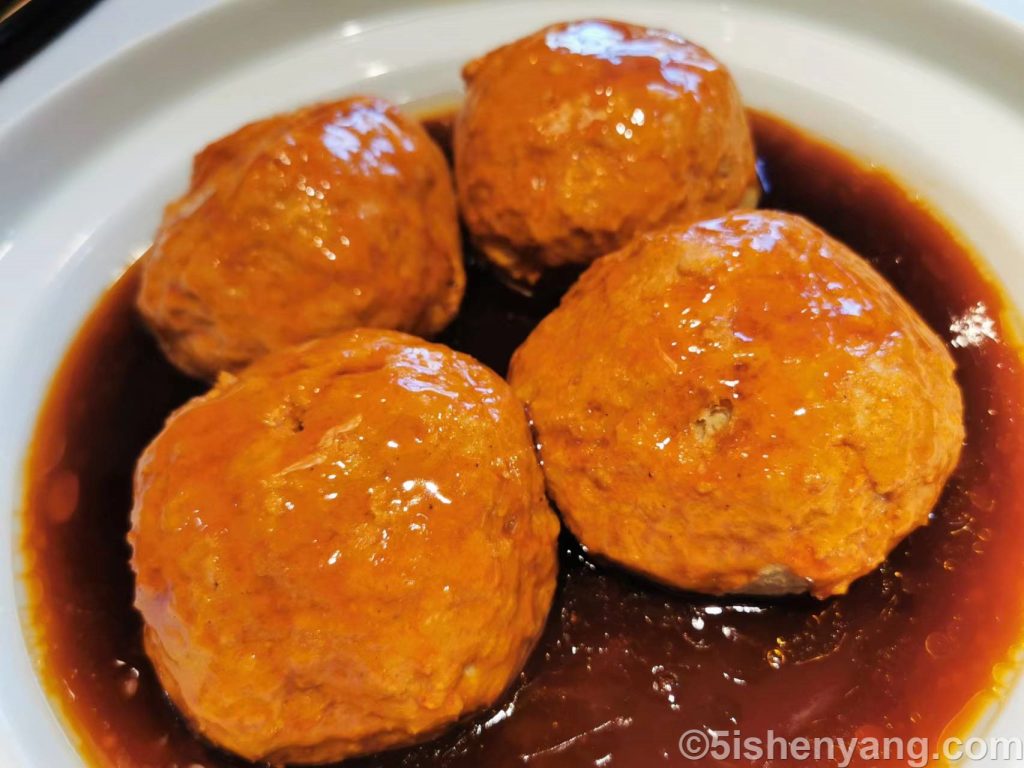Name of dish:
Chinese: 狮子头
PinYin: shī zi tóu
English: Lion Head (also more simply known as ‘Large Meatball’)
Image(s) of Dish:
Description of Dish:
Lion head, formerly known as sunflower chopped meat and sunflower meatballs, is a traditional dish in Huaiyang cuisine in China. It started in the Sui Dynasty. Legend has it that when Emperor Yang of the Sui Dynasty was traveling, the chef made squirrel mandarin fish, money shrimp cakes, ivory chicken strips and sunflower chopped meat with the theme of the four famous scenic spots in Yangzhou: Wansong Mountain, Qianqian Dun, Ivory Forest and Sunflower Hill. The four dishes were renamed Lion Head in the Tang Dynasty. This dish has a soft, waxy and creamy texture, healthy and nutritious.
This dish also exists in Yifeng, Jiangxi, and has been popular for more than 100 years. It has the characteristics of snow-white color, fresh and tender meat, fragrant and mellow flavor, and is suitable for all seasons. Every year during the Spring Festival in Chaohu area of Anhui Province, colorful balls are played with and lion dances are conducted to celebrate the harvest. The local people will make snacks shaped like lion heads to reward the lion dancers. This custom has been passed down since ancient times. This snack uses a slightly larger amount of alkali than ordinary yeast dough, so it is particularly crispy and fragrant and can be stored for several days without becoming soft.
The History of this Dish
The lion’s head is made of 60% fat meat and 40% lean meat, with onion, ginger, eggs and other ingredients chopped into meat paste, and made into fist sized Rice-meat dumplings, which can be steamed or braised in brown sauce, fat but not greasy.
The lion’s head is called “chop meat” in Yangzhou dialect, and “big meat meatball” or “four happiness meatball” in northern dialect. It is said that its “ancestor” was the “Tiao Wan Zhi” recorded in the “Food Classic” of the Northern and Southern Dynasties (“Qi Min Yao Shu, Zhi Fa 80”).
Xu Ke clearly stated in the “Qing Barnyard Banknote” that “the lion’s head is named after its resemblance, and the pork is round. The pork is half fat and half thin, and is finely cut and roughly chopped. It is mixed with protein to make it easy to solidify, or shrimp and crab meat are added. A yellow sand pot is used to place yellow sprouts or bamboo shoots at the bottom, slightly mixed with water and salt, and the meat is used to make a large circle. It is placed on it, covered with vegetable leaves, and covered with a pot cover. Then it is put into an iron pot, sprinkled with a little salt, to prevent the pot from cracking. Then it is dried with a gentle fire. Every time you burn a few firewood stops, it will be burned more about five minutes later, and it will be taken out when it is ripe..”
This dish has a long history, as the Song Dynasty poem goes: “But pairing one loaf with two crabs, there really is Yangzhou crane in the world.”. Comparing eating crab and chopping meat to a joyful fairy riding a crane down Yangzhou shows how delicious and tempting the dish of crab meal and lion’s head is.
In the Collection of Diaoding in the Qing Dynasty, there was Huai’an [2] “Big Taiwanese Meatballs” dish, which was made as follows: “Take ribs, peel them, cut them into thin strips, thick ones, add bean flour, a little seasoning, press them loosely with your hands, and do not rub them. Or fry or steam them (lined with tender green).” It can be seen that the lion’s head dish was recognized by the society in the Qing Dynasty.
The cooking of the lion’s head dish is extremely skillful. Let it simmer over low heat for about forty minutes. This way, it will be fat but not greasy and will melt when consumed. There are three cooking methods for Yangzhou lion’s head: stewing, steaming, and braising. As for the variety, there are many, including stewed crab roe lion’s head, river clam braised lion’s head, and wind chicken braised lion’s head.
The lion’s head is a type of meatball. The origin of this dish, Iron Lion Head, is due to the home of the divine physician Xilaile – Cangzhou, Hebei. The Iron Lion Head in Cangzhou is a scenic spot, so it is called this meatball Iron Lion Head. Mainly because of its large outer focus and tender inner skin. There are also Stewed Pork Ball in Brown Sauce in brown sauce, with many methods. There are also longan lion head and steamed lion head.
Legend has it that Emperor Yang of Sui stayed in Jiangnan and enjoyed countless beautiful views after visiting Yangzhou to admire the Qionghua flowers. After conquering the four famous scenic spots of Wansong Mountain, Jinqian Dun, Ivory Forest, and Kuihua Gang in Yangzhou, he greatly appreciated the beauty of the gardens and personally renamed them Qianjin Mountain, Maoerdun, Pingshantang, and Qionghua Temple. After returning to the palace, he summoned the imperial chef and asked them to develop feelings for the scenery. He made four dishes to commemorate his trip to Yangzhou in Jiangnan. (In ancient times, it was a custom to use dishes to imitate scenic gardens.) The imperial chef, King Zhan, put in a lot of effort and made four famous dishes. These four dishes are Squirrel Mandarin Fish, Money Shrimp Cake, Ivory Chicken Strips, and Sunflower Chopped Pork. After Emperor Yang of Sui tasted it, he was very happy, so he gave a banquet to his courtiers, which became a delicacy and spread throughout Jiangnan. Officials and nobles also take pride in having these four dishes as treasures when entertaining guests.
In the Tang Dynasty, there were even golden plates and jade dishes, and the best dishes were all presented. On this day, Duke Xun hosted a banquet and ordered the famous chef in the mansion, Wei Juyuan, to make four famous dishes: Squirrel and Mandarin Fish, Money Shrimp Cake, Ivory Chicken Strips, and Sunflower Chopped Meat, accompanied by delicacies of mountains and seas, as well as rare delicacies of water and land. Guests are all amazed. When the sunflower chopped meat was served, the sunflower heart made of huge Taiwanese Meatballs was as beautiful as the head of a lion. Duke Xun of the Kingdom of Xun spent half of his life in the military and achieved remarkable military achievements. Guests advised him to drink, saying, “You should wear the nine headed lion seal.” Duke Xun raised his glass and drank it all in one gulp, saying, “To commemorate this evening’s gathering, it’s better to change sunflower meat to ‘lion’s head’.” From then on, a famous dish in Huaiyang was added, which is famous for its braised and steamed dishes.
In the Qing Dynasty, when Emperor Qianlong went to Jiangnan, he brought this delicacy to Kyoto, making it one of the Qing palace dishes.
During the Jiaqing period, Lin Lan, a native of Ganquan, also sang about the “sunflower Rice-meat dumplings” in Yangzhou in his “Three Chants of Hanjiang”. His preface said: “The meat is finely cut and roughly chopped into pills, and fried into sunflower yellow with meat and vegetable oil, commonly known as sunflower Rice-meat dumplings
Date of Publication of article: 21 February 2024
The text(s), image(s) and/or video(s)used in this article were correct at the time and date of publication. All texts, images, and videos (if any) used in this article are copyright and the work & property of 5iShenyang.com and Wayne Viviers at wayneviviers.com

